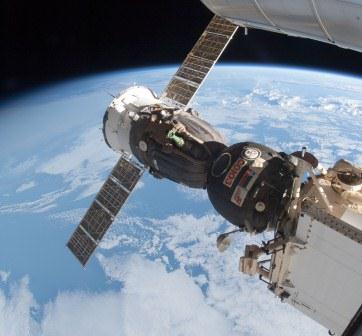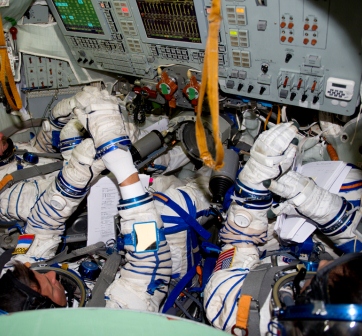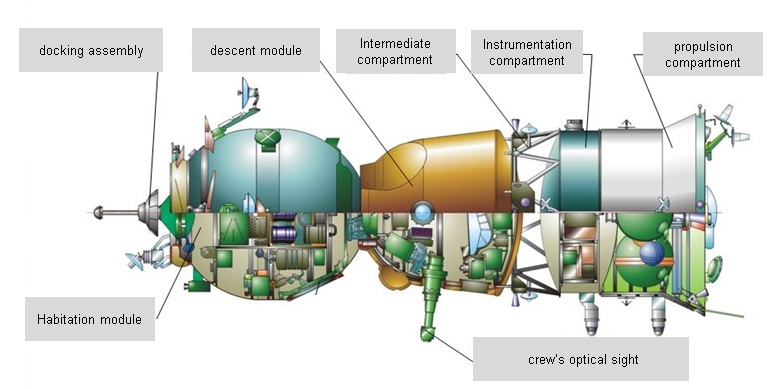Russian Soyuz spacecraft
 Russian Soyuz spacecraft history insight
Russian Soyuz spacecraft history insight
Russian Soyuz spacecraft design comes from 1962 when USSR began its Moon Program. Soon, after the Moon Program was terminated, they began designing 3-seat vehicle to make it possible to perform rendezvous, approach and finally dock to other spaceships as well as cosmonauts go from one ship to another via open space. First tests of 7K-OK Soyuz series began in 1966. Three unmanned test flights of the Soyuz vehicle were a 50% success. The fourth Soyuz vehicle test flight was piloted by cosmonaut V. Komarov – he died during descent. Then six more unmanned test flights were performed. Finally, in 1967 first automated unmanned docking of two Soyuz vehicles in space was performed. In 1968 manned Soyuz flights were resumed. In 1969 first manned docking of two Soyuz vehicles was conducted.
10 April 1971 Russians began launching a set of “Salut” orbital stations. By that time Soyuz vehicle was modified to Soyuz with a new docking cone and new communications systems to be able to dock to “Salut” orbital stations. During fourth flight of Soyuz T three cosmonauts died – the reason was a depressurization of a descent capsule during landing – three crew members were without spacesuits.
BTW: “Sokol” spacesuits have been a mandatory lifesaver to wear on the Soyuz vehicle since that tragedy. The suit keeps the crew alive to be able to control the vehicle if the descent capsule got depressed on any stages of flight. The suit automatically creates pressure inside itself if pressure in the capsule critically deviates.
After the tragedy, Russians modified the Soyuz vehicle. New redesigned vehicle was able to fit the crew of only two with their spacesuits donned. 29 Expeditions flew on this type of vehicle and docked to different Russians orbiting stations in 1970s.
Then, Soyuz vehicle was modified to be able to dock with American Apollo spacecraft.
So, speaking in general, Soyuz series vehicles were modified numerous of times in Soviet Union era until it appeared to be Soyuz T (“T” – transportation) type by 1979. It took seven years until another Soyuz modification Soyuz TM (“M” – modified) with new propulsion, parachute and docking systems, etc. appeared. First manned flight of Soyuz TM was performed 21 May 1986 to the “MIR” station; the last flight of Soyuz TM-34 was in 2002 to the International Space Station.
Soyuz TMA type was next modification which had been Russian work-horse since 2002 to 2010. “A” letter in abbreviation means “anthropometric” – Russians made changes to that time Soyuz TM vehicle making NASA and other International partners’ crew members fit in the Soyuz vehicle seats. Height and other body parameters requirements for astronauts in different countries are different.
 Russian manned spaceship today
Russian manned spaceship today
The new, since first launch in October 2010, Soyuz TMA-M manned spacecraft is still designed and manufactured by Korolev Rocket Space Corporation “Enegria”, located 7 miles north-east Moscow, under a contract to Russian Federal Space Agency.
The main purpose of the vehicle is to deliver the crew and payloads to the ISS and then back to Earth.
Soyuz spacecraft is launched to the station from rent by Russians Baikonur cosmodrome located in a former USSR Republic of Kazakhstan. The rocket which delivers the Soyuz vehicle to space is also called “Soyuz”. It now takes 6 hours from getting into space to reach and dock to ISS. However, 2-day rendezvous and docking is still a nominal case. For, example ISS Expedition 39 (two Russians – Alexander Skvortsov and Oleg Artemiev, and US astronaut Steve Swanson) had to spend 2 days orbiting the Earth and then dock to ISS in automated mode. It happens due to a trajectory miscalculation by a group of ballistic specialists.
What does Russian Soyuz spacecraft consist of?
Russian manned spacecraft composition includes: Habitation module, Descent module and Propulsion module.
Habitation module is used by the crew during spaceship autonomous flight. Primarily, it is used as a crew rest zone where they can have snacks, drink potable water, go pee, etc. but it also has a docking system with the transfer hatch to enter inside the ISS, rendezvous antennas, cameras, comm systems, and other sub-systems. The crew may take off their “Sokol” space suits during 2-day rendezvous or 6-hour rendezvous to the ISS.
In the middle of the Russian Soyuz spacecraft, a Descent module is sitting. While returning to Earth, habitation module separates from the Descent module – after the deorbit maneuver – and burns up upon re-entry into the atmosphere. The Descent module is a capsule where three crew members control the vehicle and monitor its systems operation during different stages of flight: launch, autonomous flight, rendezvous, approach, docking, undocking, maneuvering, descent and landing. All necessary controls, switches and toggles are located here in front of the crew, on the panels. While performing maneuvers or other dynamic operations the crew has to be in their "Sokol" space suits. Each crew member has his/her own custom-made seat which is individually molded to fit each person’s body – that ensures tight and comfortable fit during a touchdown. The module has a periscope, which allows the crew to view the docking target on the station. Eight hydrogen peroxide thrusters located on the module are used to control the vehicle’s attitude during descent until parachute deployment. It also has guidance and navigation control system to maneuver the vehicle. Approximately 100 pounds of payloads can be returned to the ground inside of this module. Descent module is the only one module of the vehicle to return to the Earth. The module (with the crew) lands on a steppe of Kazakhstan and cannot be used again. After landing the crew is immediately assisted by Russian rescue team which delivers the crew to rehabilitation area – Star City, Moscow for Russians, and Houston, Texas for USOS astronauts.

Propulsion module of the Soyuz vehicle is sitting on the bottom. It holds engine system with its thrusters. The module contains three sections:
a.Intermediate
b.Instrumentation
c.Propulsion
The Intermediate section is where the module connects to the Descent module. It also contains oxygen storage tanks and attitude control thrusters, as well as electronics, communication and control equipment.
The Instrumentation section is a sealed container filled with circulating nitrogen gas to cool the avionics equipment, holds the primary guidance and navigation, control and computer systems.
The propulsion section contains the primary thermal control system and the Soyuz radiator, which has a cooling area of 86 square feet. The propulsion system, batteries, solar arrays, radiator and structural connections to the Soyuz launch rocket are located here too.
The propulsion module contains the system which is used to perform any maneuvers while in orbit, including rendezvous, approach and docking with the space station and the de-orbit burns to return the crew to Earth. The propellants are nitrogen tetroxide and unsymmetric-dimethylhydrazine. The module separates from the Descent module after the final deorbit maneuver and burns up in atmosphere upon re-entry.